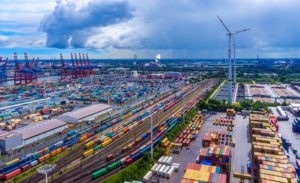IMPROVING THE COMPETITIVENESS OF RAIL FREIGHT IN THE EU

EVALUATING THE RAIL FREIGHT CORRIDORS REGULATION
Railways have the potential to play an important role in an integrated, multi-modal, sustainable transport system. To do so, they must be able to compete with other modes and rail travel across the borders between EU Member States must be as easy as it is for other modes. However, as national rail systems were developed to serve national – rather than pan-European – needs, they still often have different standards and are governed by different regulatory systems. EU policy on rail, including on rail freight, has tried to address such interoperability concerns in order to help make rail more competitive. TEPR was part of a consortium that supported the European Commission in evaluating a Regulation that aimed to improve conditions for rail freight in the EU.
The role of railways in a sustainable transport system
The use of railways for transporting freight has potential benefits in terms of improving the environmental performance of transporting freight, as well as for reducing congestion on the roads. More generally, a fully functioning, competitive railway sector is needed to ensure that the transport system can be fully integrated across all modes of transport in order to enable the most appropriate mode to be used for each part of a multi-modal journey. EU policy has, therefore, been active in revitalising the rail sector, both in terms of enabling it to be competitive and in improving the interoperability of the various national rail systems.
The development of rail freight corridors
In spite of a various pieces of EU legislation that have been put in place to support the development of the rail freight market in the EU, progress in the development of competition and interoperability had been slow. This was exacerbated by a lack of infrastructure for rail freight that was of sufficient quality and reliability, as well as a lack of cooperation between the various actors that need to be involved in transporting freight by rail1. As a result, the EU adopted a Regulation that aimed to set up so-called ‘rail freight corridors’ to help the transport of freight by rail become competitive2.
Evaluating the rail freight corridors Regulation
In 2019, it had been nine years since the rail freight corridors Regulation was adopted, and four years since the final three of the nine rail freight corridors were established. Hence, it was appropriate to evaluate the establishment and functioning of the corridors to identify the extent to which they had delivered on their original objectives. The European Commission took the decision to evaluate the Regulation, supported by a study undertaken by a consortium led by TRT, which also involved TEPR. This was published in spring 2021.
Further information
TEPR is an independent research consultancy that works on projects to improve the environmental performance of transport. For more information on the project, or TEPR’s work more generally, please contact Ian Skinner at TEPR (ian.skinner@tepr.co.uk), call +44 (0)7521 063324 or see TEPR’s website. The project produced a final report, as well as an Annex of maps of rail freight traffic and a set of Technical Annexes. The report and its Annexes are also available from the new ‘Railways and the environment’ page of TEPR’s website, where you will be able to find other reports on rail and the environment.
References
1 European Commission (2008) ‘Impact Assessment accompanying the proposal for a Regulation concerning a European rail network for competitive freight’, SEC(2008) 3029
2 Regulation (EU) No 913/2010 concerning a European rail network for competitive freight

Leave a Reply
Want to join the discussion?Feel free to contribute!